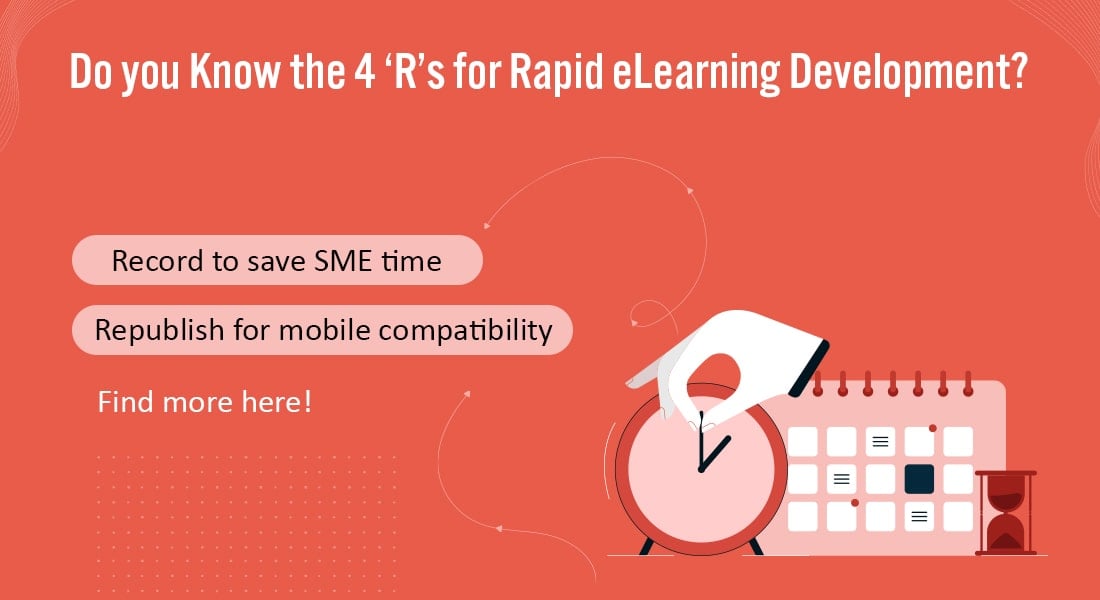What Are the 4Rs of Rapid eLearning and Why Are They so Important?

Training can make a significant difference for both employers and employees, in terms of both growth and productivity. It includes multiple steps like analyzing the learning objectives, then making plans and deciding on strategies followed by design and development of the course content. And finally putting it all together in the form of corporate training to ensure effective learning. But what to do when you need to conduct training immediately and can’t wait for months? That’s when Rapid eLearning comes into action! It is a quick rollout of the training material to meet urgent training requirements. Rapid eLearning stands tall and strong on its 4 pillars, better known as the 4Rs of rapid eLearning, which facilitate a faster and more effective rollout of training.
Without further ado, let’s know more about how these 4Rs benefit corporate training.
The 4 Rs of Rapid eLearning Can be the Game-changers For Your Corporate Training
It is because they help:
- Save time
- Reduce cost
- Minimize additional design and development efforts
- Improve recall and retention rate
What are the 4Rs of Rapid eLearning?
You definitely understand the essence of rapid eLearning which is speedy and scaled content generation without compromising the quality. The important components that help rapid eLearning deliver what it promises are the four Rs which refer to:
- Redesign – This strategy includes converting the existing classroom training material to an online format. The content is usually present in the form of training manuals, employee handbooks, etc., and can be converted into different online formats, such as VILT, blended learning, eLearning, and microlearning.
- Record- It includes creating a ‘quick and dirty’ PPT deck along with the voice recording of the SME. In this process, the number of touchpoints between the instructional designers and the SMEs are significantly reduced, which helps to save the SME time.
- Rebuild – The given strategy takes up the existing lengthy eLearning courses and reconfigures them as microlearning units like videos, infographics, interactive pdfs, and more. Microlearning refers to small bite-sized nuggets of information that cater to single-learning objective criteria.
- Republish – This strategy is used for legacy courses. Legacy courses can exist in the older versions of authoring tools or obsolete software formats. You can easily update the content by including interactivities for better engagement. This strategy enables multi-device compatibility to promote convenience, flexibility, and accessibility.
Now that we know the 4Rs of rapid eLearning, let’s explore how it can help enliven your corporate training.
Why Are the 4Rs of Rapid eLearning Important in Corporate Training?
With the biggest advantage being the facilitation of quick and speedy delivery of the training content, the 4Rs of rapid eLearning support corporate training in other ways too. Read on to know some of the reasons that make the 4Rs of rapid eLearning so important and integral to the world of corporate training.
Save Time
Whether it’s the employees or the organization, rapid eLearning benefits both of them. The 4Rs of rapid eLearning help you save time in rolling out the courses. Redesign strategy helps you save time by leveraging the already existing training content from classroom courses and converting it into online learning platforms. It offers access to learning anytime and anywhere which helps the employees save travel time or time away from desks, which can otherwise disrupt their workflow and impact their productivity. Record strategy allows you to save the SME time by reducing the number of touchpoints in the process of getting the courses approved and delivered.
Attention training managers! Are you incorporating these tips to save your SME’s time?
The Rebuild strategy entails converting the existing lengthy eLearning courses into microlearning courses that can be used for providing just-in-time information, thereby helping employees save time spent searching for relevant solutions. Republish strategy includes converting the training content into a mobile-compatible format that saves the time of learners as they don’t have to travel solely for the purpose of training. In fact, online learning courses are available at their ease and convenience, enabling them to take up the course as and when they want.
Reduce cost
Corporate training can be an expensive affair. But rapid eLearning can be used to save cost and here’s how the 4Rs help. The Redesign strategy enables you to save money as it reformats the conventional training content material to modern online learning formats which eliminate the need for in-person or classroom training, thereby cutting down on expenses related to accommodation, logistics, and training aids. Rebuilding the existing eLearning courses as microlearning units facilitates easy updation of the content without having to change the complete training material.
Republishing the legacy courses for multi-device compatibility can help increase the utility of the pre-available courses, thereby saving the cost of creating everything from the start. This strategy makes translating the courses quick and convenient by leveraging the power of rapid authoring tools. Even better, it saves the money spent on arranging equipment to conduct training as in the online mode of learning, each learner has their own device.
Minimize Additional Design and Development Efforts
Since the material from traditional classroom training is already available with most organizations, the Redesign strategy saves the effort of drafting everything from the scratch. As the mode of training delivery is different, the core content is taken up from the classroom material and modified as per the learning objectives of the training. The eLearning material includes various interactivities like quizzes, videos, infographics, gifs, drag-and-drop, and much more, which positively impact learner engagement and participation without requiring any extra effort. This is because the authoring tools contain predesigned templates which support designing eLearning courses in an easy way. Therefore, saving additional efforts of the instructional designers and helps them create courses quickly without spending too much time or effort.
With the Record strategy, rapid eLearning ensures that the information provided is accurate and technically sound as it doesn’t lose the personality of the SME. When compared to the traditional eLearning development process, the Record strategy is less hectic. It streamlines the information provided in ‘quick and dirty’ PPT along with the voiceover in an engaging manner which saves extra effort for both the SME and the instructional designers as the number of touchpoints are significantly reduced. This can enable the SME to focus their attention on the primary role and responsibilities.
Improve Recall and Retention Rate
Attention rates of adult learners are reducing quickly. The reasons vary from long duration of courses to improper spacing of training sessions. But with the 4Rs of rapid eLearning, this problem can be tackled effectively. The first R, Redesign strategy provides information in an interactive and engaging manner as the classroom training material can be converted into different digital formats, such as VILT, eLearning, blended learning, and microlearning. They ensure the information is provided to the employee in a manner that suits their learning habits. Further, the Record strategy improves employee engagement by maintaining the authenticity of the knowledge of the SME.
Rebuilding the existing course material in form of bite-sized units or small nuggets can help you improve your employee’s recall and retention rate. The content is provided in form of micro lessons which are easy to understand and remember as they try to adhere to the single-learning objective goal. This attribute also includes interactivities which make learning fun. Republishing the content in a multiple-device compatible format helps you improve the rate of engagement and participation among your employees.
Parting Thoughts
The 4Rs — Redesign, Record, Rebuild, and Republish, are the four wheels of the rapid eLearning vehicle that are driving it toward success and glory. Having a thorough knowledge of each component and how it supports rapid eLearning to facilitate productive and efficient corporate training is really important. And equally important is the design and development of your rapid eLearning courses. What are you waiting for? Learn the best practices for instructional designers by clicking on the link below.




![How 4 Rs of Rapid eLearning Transform Your Corporate Training? [Infographic]](https://blog.commlabindia.com/hubfs/blogs/rapid-elearning-4rs-corporate-training-infogrpahic.jpg)
